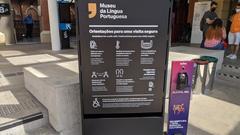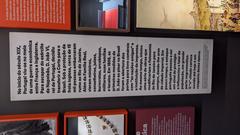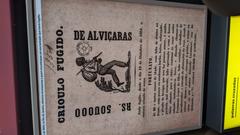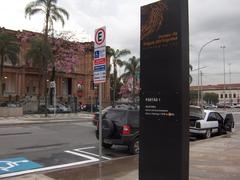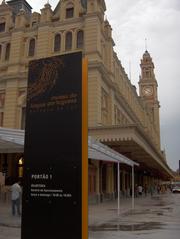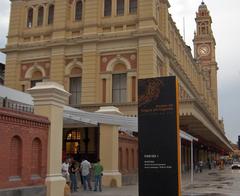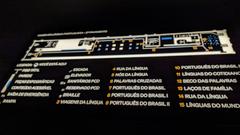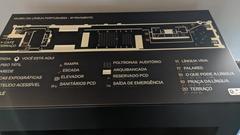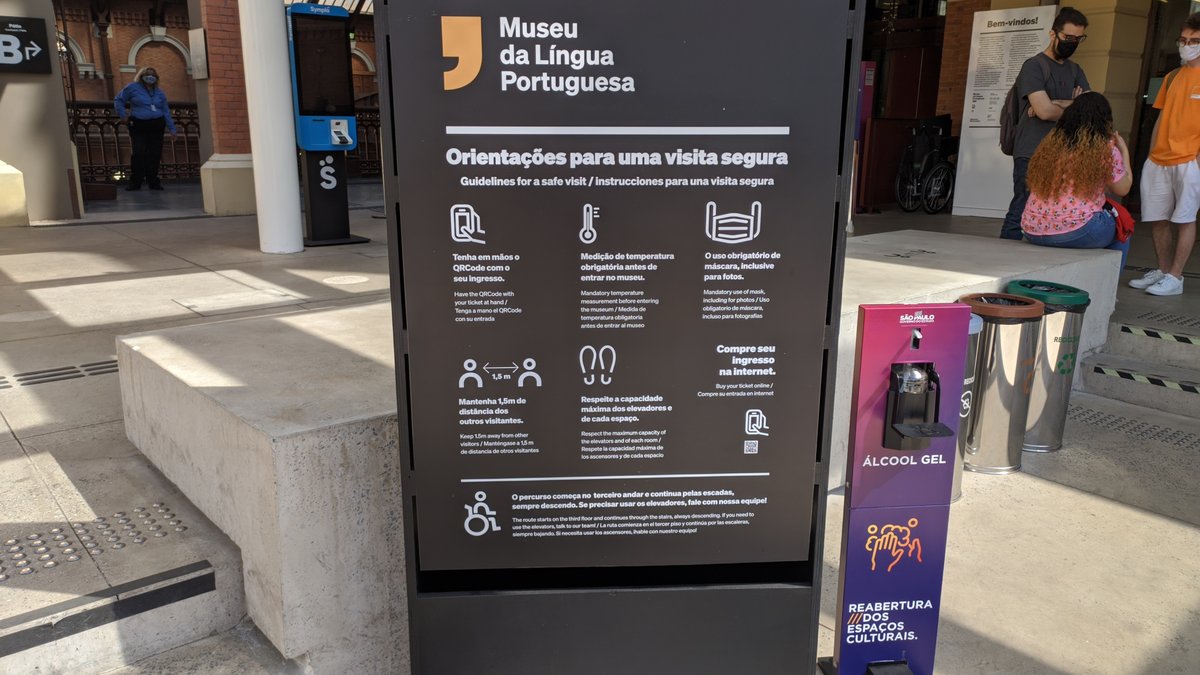
Museum of the Portuguese Language Visiting Hours, Tickets, and Guide to São Paulo Historical Sites
Introduction
Situated within the iconic Estação da Luz railway station, the Museum of the Portuguese Language (Museu da Língua Portuguesa) stands as a premier destination for anyone interested in the cultural and linguistic heritage of Brazil and the Lusophone world. Since its inauguration in 2006, the museum has offered an immersive journey through the evolution, diversity, and impact of the Portuguese language, connecting over 260 million speakers worldwide. This guide provides comprehensive information on visiting hours, ticketing, accessibility, highlights, and travel tips to help you plan a rewarding visit to one of São Paulo’s most significant historical sites.
Explore further details and virtual tours on the official museum website and Google Arts & Culture.
Historical Background and Architectural Highlights
The Setting: Estação da Luz
The museum is housed in the historic Estação da Luz, a late 19th-century railway station designed by British engineers and constructed from 1895 to 1901. Its Victorian architecture, grand façade, and iconic clock tower make it a São Paulo landmark. The restoration after a fire in 2015 preserved the station’s original charm while integrating state-of-the-art exhibition spaces (Google Arts & Culture).
Restoration and Modernization
After the destructive 2015 fire, the museum underwent a meticulous restoration, reopening in 2021 with fully renovated facilities and enhanced accessibility. The interplay between the historic structure and contemporary design provides an evocative backdrop for exploring the evolution of the Portuguese language (BBC News).
Exhibition Highlights and Interactive Installations
Permanent Exhibition Features
- Origins and Evolution of Portuguese: Interactive displays trace the language’s journey from its Latin roots to its spread across continents, with multimedia timelines, maps, and regional audio samples (Museu da Língua Portuguesa - Exposições).
- The Living Language: The “Beco das Palavras” digital corridor and “Grande Telão” audiovisual show demonstrate the dynamic nature of modern Portuguese, with real-life examples from Brazilian music, street art, and everyday speech.
- Tree of the Language: This monumental sculpture symbolizes the roots and branches of Portuguese, welcoming visitors at the entrance (WhichMuseum).
- Praça da Língua: Known as the “Planetarium of Words,” this immersive installation uses projections and soundscapes to celebrate Portuguese literature and orality (Google Arts & Culture).
- Falares: A multimedia exhibit featuring interviews and stories from speakers across Brazil, highlighting regional diversity and linguistic identity.
Temporary Exhibitions and Special Installations
The museum regularly hosts temporary exhibitions on Lusophone writers, urban language trends, and contemporary cultural themes. Recent highlights include tributes to Clarice Lispector and explorations of youth slang (Museu da Língua Portuguesa - Agenda).
Interactive Technology
Hands-on installations such as the interactive language table and digital word games engage visitors of all ages, making linguistic concepts accessible and fun (WhichMuseum).
Visitor Information and Amenities
Visiting Hours
- Tuesday–Sunday: 10:00 AM – 5:00 PM (last admission 4:30 PM)
- Closed: Mondays and certain holidays
Tickets and Admission
- General admission: R$20 (2025 rate)
- Discounts: Students and seniors pay R$10; children under 7 enter free; free entry on Saturdays
- Purchase: Buy tickets online via the official website or at the museum entrance
Accessibility
The museum is fully accessible, featuring ramps, elevators, tactile floor markings, adapted restrooms, and audio guides in Portuguese, English, and Spanish. Many exhibits include subtitles or sign language interpretation to ensure an inclusive experience.
On-site Amenities
- Café: Enjoy Brazilian snacks and coffee with views of Praça da Luz
- Bookstore: Offers literature, language learning materials, and souvenirs (Museu da Língua Portuguesa - Loja)
- Wi-Fi and Charging: Free Wi-Fi and charging stations are available throughout the museum
- Rest Areas: Comfortable seating for relaxation
How to Get There
- Location: Praça da Luz, central São Paulo
- Public Transport: Directly accessible from Luz metro and train stations, connecting to multiple city lines
- Parking: Limited parking nearby; public transport is recommended due to central location
Guided Tours and Educational Programs
The museum offers guided tours in Portuguese and English, lasting 60–90 minutes. Group tours and tailored educational visits are available for schools, with supporting materials provided (Museu da Língua Portuguesa - Educational). Workshops, readings, and debates enrich the cultural calendar.
Practical Tips for Visitors
- Best Times: Visit on weekday mornings for fewer crowds; Saturdays are free but busy
- Duration: Plan to spend 1.5–3 hours to explore all exhibits
- Photography: Allowed in most areas without flash; check signage for restrictions
- Safety: The district is generally safe, but take standard precautions, especially in the evening
Nearby São Paulo Historical Sites
Enhance your cultural itinerary with these nearby attractions:
- Pinacoteca de São Paulo: Renowned art museum adjacent to the museum
- Jardim da Luz: A tranquil historic park perfect for a stroll
- Sé Cathedral: São Paulo’s neo-Gothic landmark a short metro ride away
Special Events and Community Engagement
Throughout the year, the museum hosts events such as book launches, poetry slams, and the annual “Festa da Língua” on International Portuguese Language Day (UNESCO - Portuguese Language Day). Collaborations with Lusophone communities and local schools emphasize cultural exchange and literacy.
Sustainability and Social Impact
The museum is committed to sustainability and heritage preservation, partnering with local communities to promote linguistic diversity and education. Its restoration is a model of blending historical preservation with modern use (ICOM Brazil).
Frequently Asked Questions (FAQ)
Q: What are the Museum of the Portuguese Language visiting hours?
A: Tuesday to Sunday, 10:00 AM–5:00 PM. Closed Mondays.
Q: How much are tickets?
A: General admission is R$20; discounts for students and seniors; Saturdays are free.
Q: Is the museum accessible?
A: Yes, with ramps, elevators, tactile markings, and multilingual audio guides.
Q: How do I get there?
A: Take the metro or train to Luz station; limited parking is available nearby.
Q: What are nearby historical sites?
A: Pinacoteca de São Paulo and Jardim da Luz are within walking distance.
Visuals and Virtual Experiences
Alt: Museum of the Portuguese Language entrance at Estação da Luz, São Paulo historical site Alt: Tree of the Language sculpture inside the museum
Final Tips and Summary
The Museum of the Portuguese Language provides an engaging and educational experience, blending São Paulo’s architectural heritage with modern interactive exhibitions. To make the most of your visit:
- Confirm visiting hours and buy tickets in advance
- Consider a guided tour for richer context
- Allow time to explore both permanent and temporary exhibitions
- Combine your visit with nearby cultural sites
- Take advantage of the café, bookstore, and virtual resources
For the most current information, upcoming events, and virtual experiences, visit the official museum website and Google Arts & Culture. Download the Audiala app for audio guides and discover more about São Paulo’s vibrant historical landscape.
References
- Museum of the Portuguese Language in São Paulo: History, Visiting Hours, Tickets, and Travel Tips, 2025 (Museu da Língua Portuguesa)
- Discover the Museum of the Portuguese Language in São Paulo: Visiting Hours, Tickets, and Cultural Highlights, 2025 (Google Arts & Culture)
- Visiting the Museum of the Portuguese Language in São Paulo: Hours, Tickets, and Highlights, 2025 (WhichMuseum)
- Museum of the Portuguese Language Visiting Hours, Tickets, and Guide to São Paulo Historical Sites, 2025 (Museu da Língua Portuguesa)
- BBC News: São Paulo museum reopens after fire, 2021 (BBC News)
